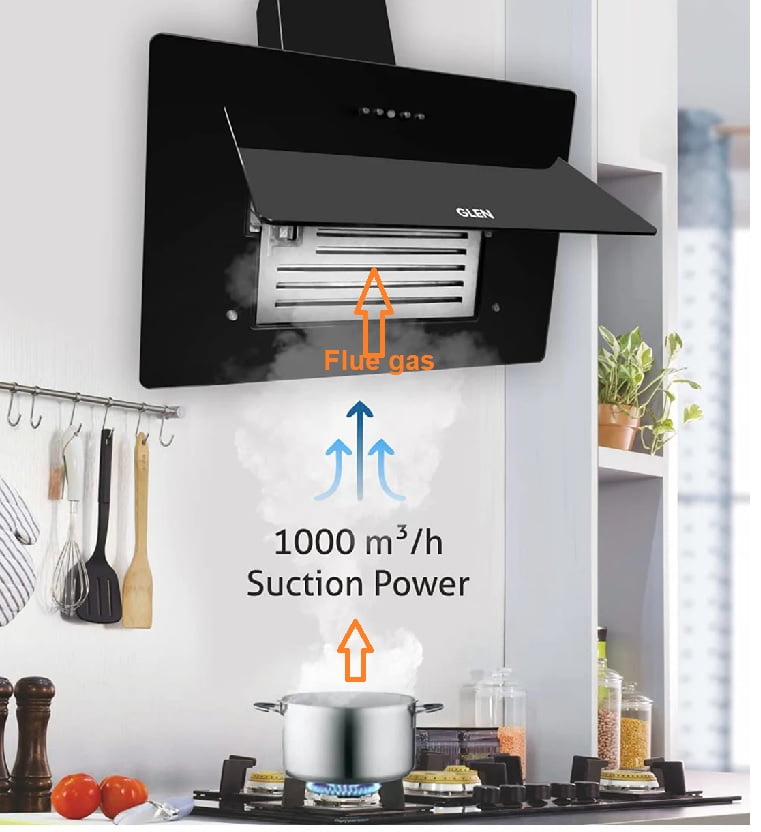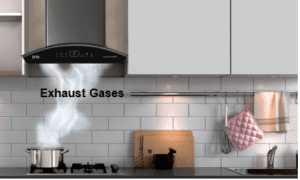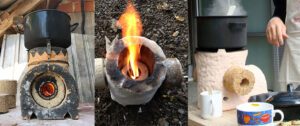What is a Kitchen Chimney or kitchen hood?
- it is ducting fitted right above the gas stove in the kitchen as shown in the post.
- During cooking oil, smoke, steam, and odor are generated during cooking. These things flow upward through the ducting
- The oil gets trapped in the oil collectors but smoke, steam, smoke/ black particles, and heat is exhausted of the kitchen through the duct
Working Principle of Kitchen Chimney
- Chimneys operate based on the principle of natural circulation that hot(low-density) air rises upward and cold air pushes hot air inside the chimney
- When a chimney is filled with hot smoke or other gases, these gases rise up through the chimney
- The hot rising gas creates a pressure difference known as a draft which pulls combustion gases out of the building.
- A kitchen chimney, a range hood, operates based on a simple yet effective principle of capturing and expelling airborne particles such as smoke, grease, and odors generated during cooking.
- Here’s a detailed explanation of its working principle:
Working Process
-
- Suction: The fan or blower creates a suction effect, drawing in the smoke, grease particles, and odors from the cooking area into the hood.
- Filtration:
- In ducted chimneys, the air passes through grease filters to trap grease particles.
- In ductless chimneys, the air also passes through charcoal filters to remove odors.
- Exhaust:
- In ducted chimneys, the filtered air is expelled outside through a duct system.
- In ductless chimneys, the purified air is recirculated back into the kitchen after passing through the charcoal filters.
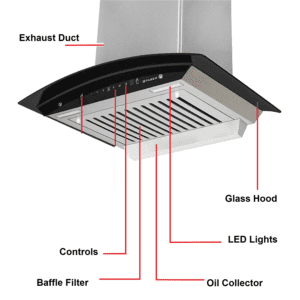
Components of Kitchen Chimneys
- Hood: The canopy or enclosure that captures the rising smoke and vapors.
- Filters:
- Grease Filters: Typically made of stainless steel or aluminum, they trap grease particles.
- Charcoal Filters: Used in ductless chimneys to absorb odors.
- Fan or Blower: Creates suction to draw in the air.
- Duct: A passage to expel the filtered air outside (in ducted chimneys).
- Control Panel: For adjusting fan speed and lighting

Types of Kitchen Chimneys
- Ducted Chimneys: These chimneys expel the air outside the kitchen through a duct. They are more efficient in removing heat, smoke, and odors.
- Ductless Chimneys: These chimneys recirculate the filtered air back into the kitchen. They are easier to install and are suitable for kitchens where duct installation is not feasible.
What are the benefits of a Kitchen hood?
- It is useful for your home to exhaust smoke and fumes generated from gas stoves or cooking
- Keeps the kitchen air clean and odorless
- Chimneys help recirculation of fresh air inside the kitchen
- Reduces the amount of heat while cooking: …
- Adds a style quotient.
- Make kitchen working more healthy and reliable
- Improves Air Quality: Removes smoke, fumes, and odors, enhancing the kitchen’s air quality.
- Reduces Grease Buildup: Traps grease particles, reducing greasy residues on kitchen surfaces.
- Enhances Kitchen Cleanliness: Keeps walls, tiles, and other surfaces cleaner by capturing airborne particles.
- Adds Lighting: Provides additional lighting for the cooking area.
Where Kitchen Chimney is Installed?
- The kitchen chimney is installed just above the gas stove
- A sufficient draft must be provided to create low pressure in the duct using the fam to exhaust all flue gases
- A filter is fitted at the inlet to remove smoke and oil particles
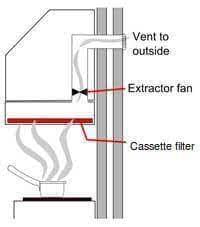
- Installation of the chimney is shown below
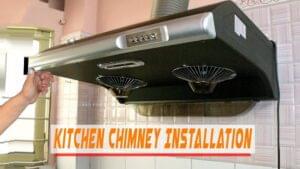
Chimney for biomass stoves
- A chimney for biomass stoves functions similarly to a kitchen chimney
- It is designed specifically to handle the smoke and particles generated by burning biomass fuels such as wood, pellets, or agricultural residues.
- Here’s an explanation of how a biomass stove chimney works:
- Computational Fluid Dynamics (CFD) plays a crucial role in the design and optimization of chimneys, whether for residential, industrial, or biomass stoves.
- Here’s an exploration of the scope of CFD for chimney design:
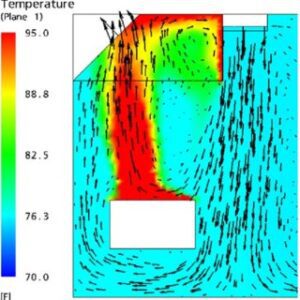
Applications of CFD in Chimney Design
- Flow Analysis:
- Airflow Optimization: CFD helps in analyzing the airflow within the chimney, ensuring efficient expulsion of smoke and gases.
- Draft Calculation: Accurately predicts the draft generated by the chimney, which is essential for maintaining optimal combustion conditions.
- Thermal Analysis:
- Heat Transfer: Evaluates the heat transfer characteristics within the chimney to ensure materials can withstand the operating temperatures.
- Temperature Distribution: Analyzes temperature gradients to prevent hot spots and ensure even heat distribution, which can affect structural integrity and safety.
- Pollutant Dispersion:
- Emission Control: Models the dispersion of pollutants and particulate matter to ensure compliance with environmental regulations.
- Smoke Behavior: Simulates the behavior of smoke under different conditions, aiding in the design of chimneys that minimize smoke re-entry into living spaces or surrounding areas.
- Structural Integrity:
- Stress Analysis: Assesses the structural stresses and thermal expansion effects on chimney materials to prevent failures.
- Material Selection: Helps in selecting appropriate materials that can withstand the thermal and mechanical loads experienced during operation.
- Design Optimization:
- Geometry Optimization: Optimizes the shape and dimensions of the chimney for improved performance and efficiency.
- Component Design: Aids in designing components such as baffles, dampers, and caps for enhanced airflow control and safety.
Benefits of Using CFD in Chimney Design
- Improved Efficiency: By optimizing airflow and heat transfer, CFD can significantly enhance the efficiency of chimneys, leading to better combustion and reduced fuel consumption.
- Enhanced Safety: CFD simulations help identify potential issues such as hotspots, structural weaknesses, or insufficient draft, allowing for design improvements that enhance safety.
- Environmental Compliance: Helps in designing chimneys that meet stringent emission standards by analyzing and controlling pollutant dispersion.
- Cost Savings: By predicting and mitigating potential problems early in the design process, CFD reduces the need for costly modifications or repairs post-construction.
- Customized Solutions: Allows for the creation of customized chimney designs tailored to specific operational requirements and environmental conditions.
Typical CFD Workflow for Chimney Design
- Problem Definition: Identify the objectives of the CFD analysis, such as improving draft, reducing emissions, or ensuring structural integrity.
- Geometry Creation: Develop a detailed 3D model of the chimney, including all relevant components and features.
- Mesh Generation: Create a computational mesh that discretizes the geometry into smaller elements for numerical analysis.
- Boundary Conditions: Define the boundary conditions, including inlet and outlet conditions, heat sources, and material properties.
- Simulation Setup: Configure the CFD solver settings, including turbulence models, heat transfer models, and convergence criteria.
- Simulation Execution: Run the CFD simulation to obtain flow, temperature, and pressure distributions within the chimney.
- Results Analysis: Analyze the simulation results to identify areas for improvement and validate the design against performance criteria.
- Design Iteration: Make necessary design modifications based on the CFD analysis and repeat the process until optimal performance is achieved.
Maintenance
- Regular Cleaning: The chimney and flue pipe should be cleaned regularly to remove soot, creosote, and other residues that can build up and cause blockages or chimney fires.
- Inspection: Regular inspections are essential to check for damage, corrosion, or blockages and to ensure that the chimney components are in good condition.
- Flue Liner Maintenance: The liner should be inspected for cracks or damage and replaced if necessary to maintain the chimney’s efficiency and safety.
- By leveraging CFD, engineers and designers can create more efficient, safe, and environmentally friendly chimney systems, leading to better overall performance and reduced operational costs
